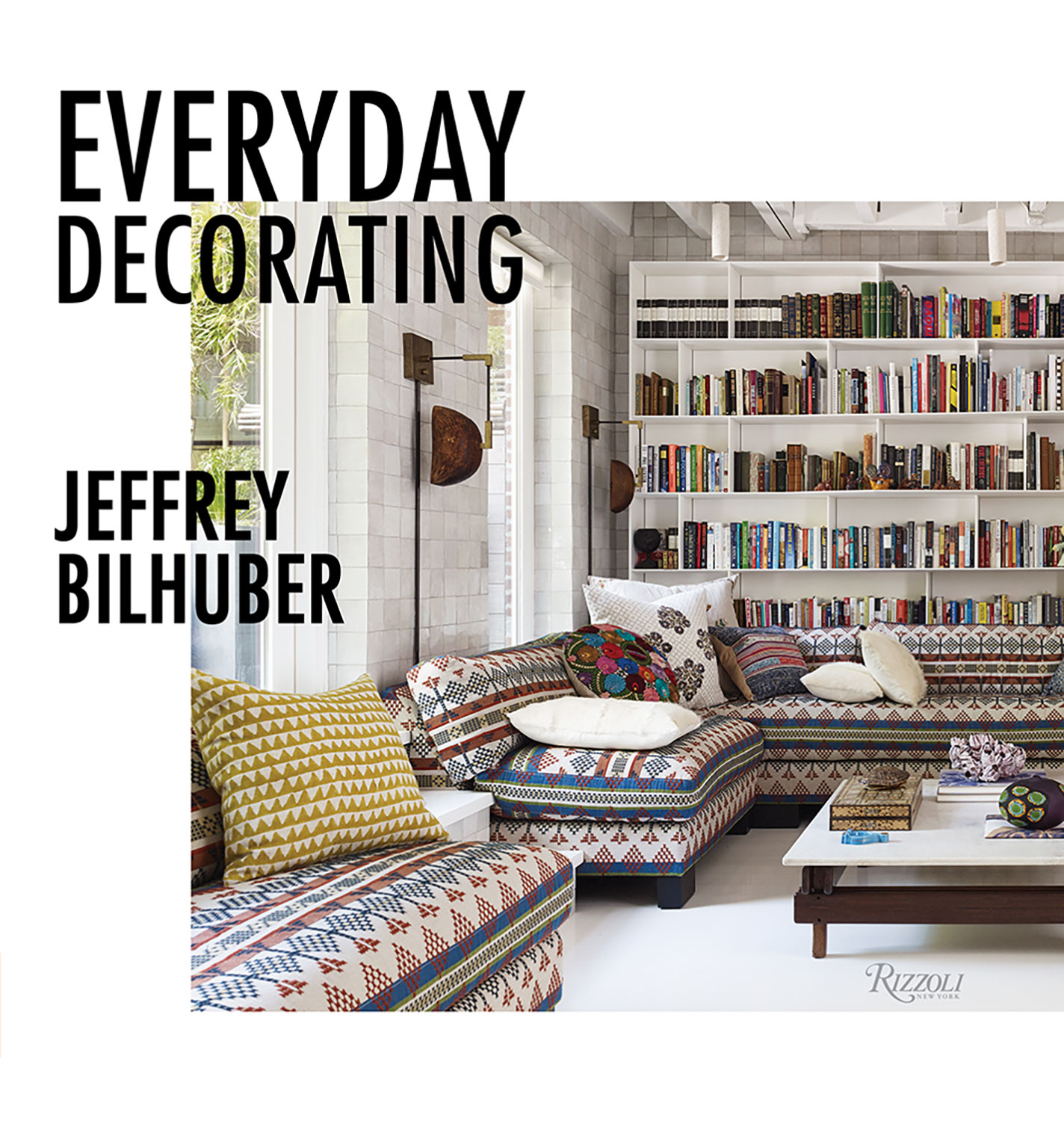
Interior designer Jeffrey Bilhuber. Photo by Kelly Taub
Q&A
Flower: Congratulations on your new book, Everyday Decorating, (Rizzoli, 2019). With four books in print, why did you feel the need to write this one?
Jeffrey Bilhuber: This is the book I’m proudest of because it’s the most modern and approachable. What I am going for is my own print version of Instagram, where, rather than one continuing narrative, you can open up any page and find information that is useful, energizing, and effervescent.
You organized this book not by aesthetic looks, but by the way rooms make us feel, with chapter titles like “Happy,” “Comfortable,” “Charming,” and “Personal.” Why this approach?
It’s been on my mind for years. I have a diverse group of clients and a diverse body of work. I’m as happy decorating a 4-bedroom country house as I am doing a 12-bedroom Park Avenue apartment. I’ve noticed that when I sit with clients for their initial meeting, regardless of their property, terrain, or climate, they always come up with the same priorities. People will say, “It doesn’t matter what you do, as long as these rooms are charming or cozy or bright.” Whether they’re spending $10,000 or $10 million, these universal goals are always the key criteria.
Most designers write books with gorgeous images of interiors and leave it at that. I loved how inviting and unpretentious your book is, how you mix the beautiful pictures with practical advice like the ideal depth of a seat cushion.
After many years practicing my trade, I’ve realized there’s a blueprint for great projects and there are certain rules that really don’t bend. Once you know what those working blueprints are, you can expand on them. I wanted to make sure, for instance, that people understood that 16 inches is a magic number for the distance between a chair and a coffee table. This book is geared toward anyone who enjoys the challenges and triumphs of design and needs some education. After all, we are all better when we’ve had the pleasure of being educated.

Details such as the light-green curtain trim and the abundance of nailheads on the headboard draw you into this Jeffrey Bilhuber designed bedroom. Photo courtesy of Henredon
So you won’t mind if you see a copy studded with Post-it Notes and dog-eared pages?
What I didn’t want this book to be was some massive book gathering dust on the coffee table with a potted orchid resting on top. That’s an author’s biggest fear—to be a plant stand. I wanted this to be a traveling book, a nightstand book. I’m convinced in decorating it’s more expensive to get it wrong than to get it right, so you might as well go in armed with information.
I really appreciate your attention to detail, how you anticipate the way small things—the placement of a side table, the way a lamp casts light—contribute to the overall experience of a space.
Talk about how those factors play into your overall scheme. It’s vital to understand how people navigate through space. There are certain needs that each room should respond to. For instance, if you know you’ll want to put a coffee mug down in front of you when you watch the morning news, then you’ll need a table 21 inches high.

“I’m at my zippiest when pulling colors together because I love them—not simply because they’re a small part of some larger multicolored chintz,” says designer Jeffrey Bilhuber. In his Locust Valley home, Bilhuber went with bold colors against a paneled wall dotted with resin antlers. Photo courtesy of One King’s Lane
Color is a signature element of your work. In one chapter you write, “Go ahead and say it, ‘Purple, purple, purple!’ ” So many people shy away from color. Why do you love it?
I am very confident when it comes to color. Color is a way for someone to say I’m confident in myself. I love using saturated hues, but I use them in isolation—not how it was used in the 1970s when you’d walk into a red library and feel like you were having a drink with Satan. For me, color is like an exclamation point at the end of a sentence.
Alongside all the wit and wisdom in the book, there’s some tough love too. You write, “That old adage that a room is never done is completely untrue. You must know when to stop.” So, when is it time to stop?
At some point a room can start to feel claustrophobic. You can sense it. Anything you love can find a place in your home, but there is such a thing as being loved too much!

A wicker basket, a copper pot, and a bamboo curtain rod come together to create an unabashedly charming room. There’s nothing saccharine here. It’s a mix of patterns, colors, and details that deliver joy with their unexpected whimsy and creativity. A bench with a seat cushion and throw pillows makes for a relaxed breakfast or lunch. Photo by Chichi Ubiña

An intense blue entrance connects to a white living room through the consistency of a painted floor. Photo by Julian Wass
Despite all the book’s do-it-yourself advice, you still make the case for using a professional. What value does a designer offer?
I’m convinced that great decorating is no more than great communicating. Decorators, at their best, can take your taste and make it even better—they can move it forward. In this book I’m helping the reader define their taste, so they can be conversant in the design of their rooms. And, should they have the good fortune to work with a decorator one day, they will be that much more enlightened to get the best result.
By Kirk Reed Forrester
Everyday Decorating by Jeffrey Bilhuber (Rizzoli, 2019). Book cover photo by Björn Wallander
MORE INTERIOR DESIGNERS TO KNOW




